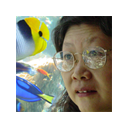Students will take home letters tomorrow showing a digital work by each student and a letter explaining our summer class. We began ceramic tile glazing in the first class but because I needed to meet with each student to download and design the letter, the students in the second class did not begin glazing. It would have been better for each student to have a computer with Adobe Elements. The students with Punahou iBooks do not have Adobe Elements.
The technical skill using Adobe Elements is proficient for most students. But I sense frustration on the part of students as to problem solving without structure as to their choices of the tools to use. When I am with the student, they feel more comfortable to to abstract their work, and are perhaps more spontaneous. I validate the abstraction and ask them to make choices about size, color changes etc. The images that were done without my assistance are more literal, representational, and close to the original drawing or painting. Abstraction will develop with experience in using the effects and seeing the work of others.











 Melissa Kim Mosher's Summer Lab School Blog
Melissa Kim Mosher's Summer Lab School Blog
Comments (3)
Melissa:
I was intrigued with your statement in this parent letter that the "critical difference" in the story telling the students would do in your class was that they would start with the visual image. I began to imagine a storyboard of the fish, or whatever, and to imagine a story without words. What a nifty imaginative process.
Are you following up this "critical difference," the differing way being, I am assuming, to start with the verbal narrative.
My questions would be: 1) Is there a difference? 2) what is the difference? 3) For what students or kinds of students (or learning styles of students)? 4) Does starting with the visual image inspire verbal students to use more metaphor in the their verbal stories, etc..????
Thanks for thought provoking work. Please let me know if you have responses and data to my wonderings.
Posted by Diane Anderson | June 27, 2007 1:52 PM
Posted on June 27, 2007 13:52
Melissa,
Diane's comments got me thinking about a project a couple of teachers did at my school this past year that I thought had some interesting aspects.
The project did NOT have students from each class even meet each other until the last day which I thought was a subtle, but important element of the project.
The digital photography students were asked to take a photograph that they believed contained some sort of emotional imagery. Each student sent an anonymous copy of his/her photograph to a student in the other teacher's basic English class. Not knowing anything about the photographer, each student in the English class had to write a "poem" inspired by the imagery of the photograph. These students were each given one photograph randomly and they had to write about the photograph they were given regardless of whether they happened to like the photograph or not. Then the photographs and poems were returned to the original photographers who had to "see" what some anonymous English student had written about the photograph. The final step of the creation process was that the photographer had to take the text of the poem and design an image that included the photograph with an overlay of the poem. They had to deal with font selection and placement of text that was going to "block" some elements of the photograph.
Then finally, when everything was done, the students in each class were brought together to "meet" their collaborators and simply get a chance to talk about what each had done.
I spent the entire 90 minute period watching this process and it was inspiring. Because of the anonymity, kids were conversing with other students that they quite likely would never have interacted with before. Each was truly interested in the way his/her partner had interpreted the other's work. And, each felt truly "honored" by how their work had inspired their partners. I saw photographers who witnessed the inspiration they had brought to poets and poets who witnessed the impact of their poems on photographers and their conversations were, well... they were authentic at some of the deepest levels I've seen in quite some time.
jerome
Posted by Jerome Burg | June 29, 2007 3:59 AM
Posted on June 29, 2007 03:59
I am fascinated by both Melissa and Jerome's ideas. Starting with imagery as a way of story telling helps some students elaborate their idea before they need to put words to it. Then they can go back to the visual to see what is there, what needs to be written about it. This was confirmed in the experience of teaching Arts and Letters.
The added concept of sending work to an "authentic audience" a poet to write about the art work is brilliant! I will be looking for an English class to partner with on this idea! Thanks for these great ideas! ci
Posted by Carole Iacovelli | June 30, 2007 9:56 AM
Posted on June 30, 2007 09:56